At 8:00am, October 15, at last we embark on the long-anticipated trip to Yading, or formally known as Yading Nature Reserve. We slowly drive through the downtown of Daocheng, strictly following our navigator Kailide Auto GPS with auto surveillance camera.
We’ve enjoyed the freedom with the helpful GPS guide and it seldom lets us down. Now we are guided to move on the provincial-level highway S216, a 71 km drive from Daocheng to Shangri-la Town ( formerly Riwa Town日瓦乡 ).
Euphrates Poplar Forest 胡杨林
It is cloudy in the morning and we are all happy about the weather as long as it doesn’t rain or snow. The highway S216 is surprisingly in good condition, a wide and flat asphalt road with clean iron handrails and clear road signs. The road meanders on the wide and flat valley flanked with fields, meadows, Tibetan houses and undulating hills, all coated with autumn golden hues.
In half hour we become excited at the sights outside – rows and rows of the Euphrates Poplar trees (also known as Diversifolius Poplar or simply poplar trees) along the highway. The poplar trees change colors with seasons – green in spring and summer, yellow and golden on autumn, and red in winter, a great photograph opportunity.
We cannot resist the temptation and stop our Highlander by the roadside and walk down to the roadside river area. We snap some photos of the golden-colored poplar trees and the snow-shrouded mountains far behind.
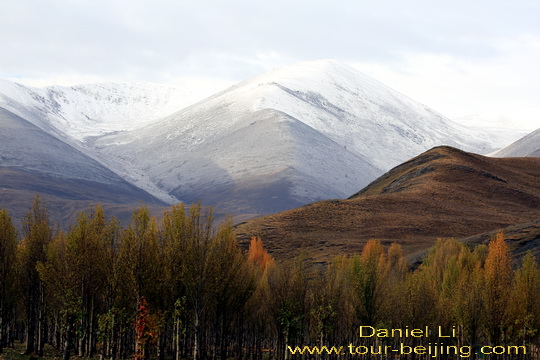
Rewu Monastery 热乌寺
Back to our white horse and continue our overland trip. It is again a scenic drive along the highway S216. We don’t have enough eyes to scan and enjoy all the beautiful roadside landscapes moving fast away from our car to the distance. About 15 km in the south of Daocheng downtown, we are passing by a group of Tibetan style houses, white wall with red roof, dotted on a relatively flat hillside on our front right side.
While still puzzled at the place, a big roadside sigh tells it is a Buddhist temple named “Rewu Monastery”, plus a piece of message – there is a viewing platform 1000m ahead to view the temple.
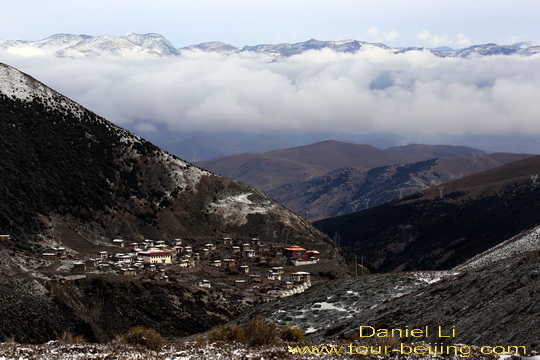
Mr. Chen skillfully brings his Highlander to the parking lot on the viewing platform. “Rewu” literally means “Where the jar breaks is the place for the construction of the temple” in Tibetan language. The temple was originally built at the end of the Southern Song Dynasty with a history of over 600 years.
The monastery remains two parts – Upper Temple and Lower Temple. The Upper Temple belongs to Gelugpa school of Tibetan Buddhism while Lower Temple belongs to Sakya school of Tibetan Buddhism. The two religious sects coexist in the same place and live in harmony, which is quite rare in the temples of Tibetan Buddhism.
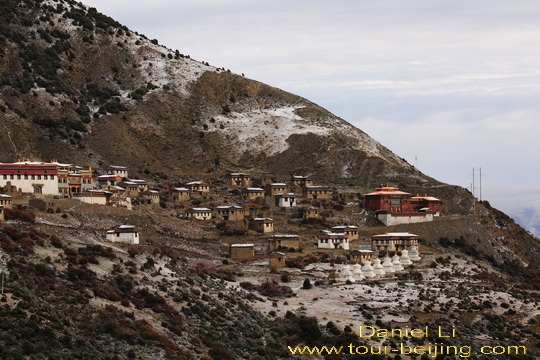
Bowa Mountain and Lover Lake 波瓦山和情人湖
Again return to our white Highlander and continue our drive trip down south. This time we can feel we are moving to higher altitudes.
About 23 km in the south of Daocheng downtown, we get over the highest point en route – Bowa Moutain Pass at the sea level of 4513m.
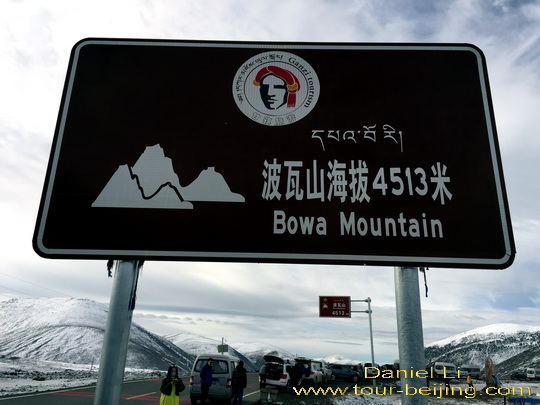
Having passed over several over-4000m mountain passes in the past few days during our drive trip, we don’t feel Bowa Mountain Pass has anything special. Mrs.Chen Ya does mention that “Bowa” means “Heroes, heroic mountain” in Tibetan.
In the past, the Tibetans in Sela Village at Bowa Mountain would retreat to the mountain for defense if they faced outside intrusion. At the same time the local Sela Tibetans would take advantage of the rugged terrains of Bowa Mountain, beating the outside aggressors. There had appeared legion of heroes in the course of protecting their homeland.
She also talks about a plateau lake below the road cutting through the mountain pass. The lake is linked to a local sad story. The story goes that there was a brave and handsome young man named “Sangjizhima”(桑吉志玛) loved by plenty of local Tibetan girls. But he refused all of them because he had deeply loved a Han girl far far away. His persistent pursuit at last won her heart.
On the early morning of the day for marriage, he and his family members started to wait on the road, but till sunset he still could not see her sweetheart appear. Under desperation, he took out his bow and shot an arrow in the direction of the road leading to his house. Unfortunately, the arrow hit his bride dead on the road. His bride fell down and became the mesmerizing Sela Pasture. With mixed feelings, the young man took out his sword and killed himself, turning himself into the beautiful Bowa Mountain and accompanying his darling forever.
According to the legend, the lake is known as “Lover’s Lake” which is formed and fed by Sangjizhima’s tears. Such a sad story, well let’s to have a look at the lake. Getting off our Highlander, we walk across the road and see the lake below. Oh, My Jesus! I’m utterly shocked at the sight spreading before us – a limpid and opening eye of water embedded on the flat land surrounded by the mountains. Are you waiting for me? Oh, please don’t close your eye. I’m coming!
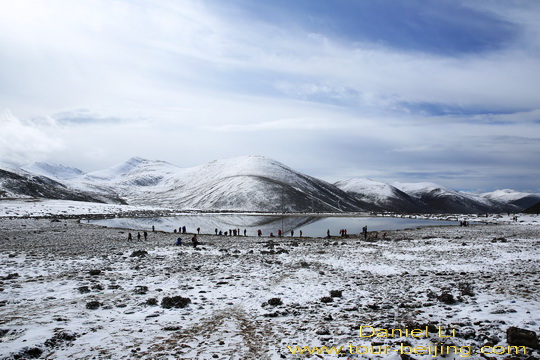
I quickly walk down to the open expanse covered with white snow before the lake. Very soon I find my shoes are wet. It is a marshland with water underneath – Sangjizhima’s running tears?
I cannot walk fast and bog down for many times before I get to the edge of the lake. It is an eye of the plateau mirror, an eye of love and an eye of purity!
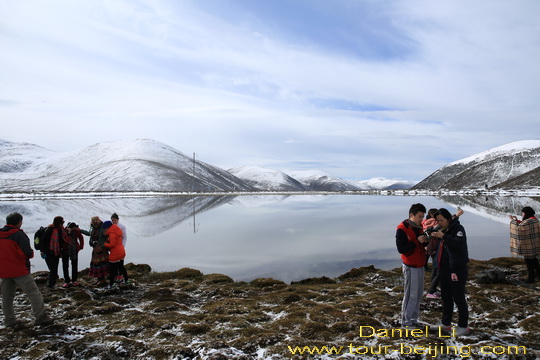
It is an arrow of the sad story! It is an arrow of defending the Sela homeland. It also reminds us of the fact that the world is originally pure and clean, physically and spiritually.
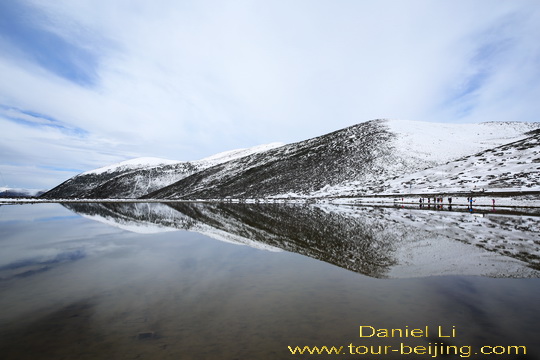
The upside down reflection of the landscape is just stunning, a rare sight in a low altitude area as we live in Beijing, Shanghai etc. This is one of the reasons for people to come here despite of the long distance and high elevation.
Human beings never stop seeking something true – true love, true friends, true meanings of life and more “true”…
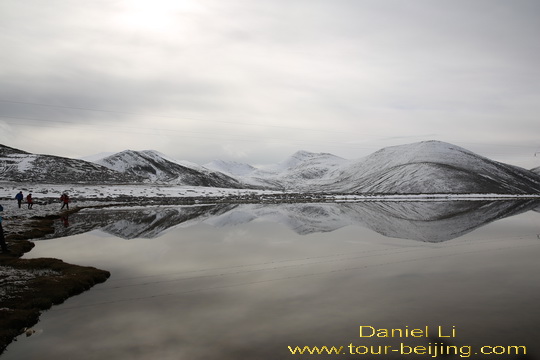
We reluctantly leave this amazing place. But we have to move back over the swamp to the main road – S 216 and continue our road trip to Yading Nature Reserve.
Zhongdui New Village 仲堆新村
Leaving Lover Lake far behind, we are descending down the mountain south in the direction of Yading. About 65 km south of Daocheng downtown, seemingly in the middle of nowhere we spot rows and rows of Tibetan houses and barley fields.
Being curious about how to live in such a harsh place, we stop and take out our cameras to shoot the well-maintained Tibetan village. Later we know it is Zhongdui New Village.
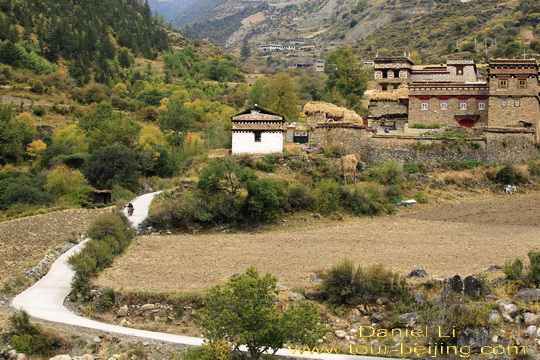
We see a group of Tibetans in the village making a small kora walking around a sacred house below the main road. Tibetans have religious belief, and pay great respect to the harmony of human beings, animals and nature.
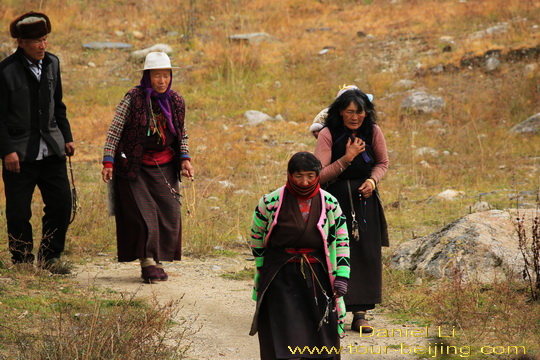
Shangri-la Town and Tourist Service Center 香格里拉镇和亚丁风景区游客服务中心
Shangri-la Town ( not Shangri-la in Yunnan Province ) is only 6 km south of Zhongdui Village and 34 km to the north of Yading Nature Reserve. Mr.Chen accelerates his engine and soon we find ourselves in Shangri-la Town ( formerly Riwa Town) at 11:30am. We decide to stop in the town for lunch and a short break as well.
Shangri-la Town is the last outpost before you get to Yading Nature Reserve. For the 34km road trip from Shangri-la Town to Yading Nature Reserve, people have to leave their own vehicles in the town and use the official eco shuttle buses to get to Yading Nature Reserve. You need to buy a combo-ticket 270 yuan ( entrance and shuttle bus) at the tourist service center which is located on the southern edge of the town.
The town has become an international tourist center for visiting Yading Nature Reserve with ever-increasing number of hotels, restaurants and other travel related facilities. We choose a roadside Sichuan food restaurant known as “Ya’an Restaurant” for our lunch.
Over lunch, we also discuss where we should stay overnight today. Basically we have three choices for accommodations – hotels in Shangri-la Town; hotels in Yading Village and the temple-turned inn in Longtong Ba (龙同坝), a bit far from the village center.
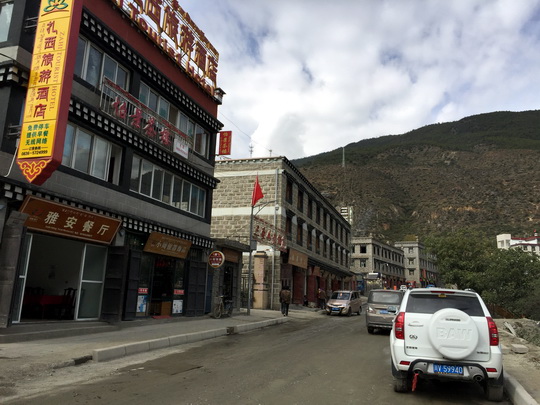
Mrs. Chen Ya suggests that we should stay at the temple-turned inn at Longtong Ba simply because Longtong Ba is close to the entrance to the paid Yading Scenic Area, so we are able to get to the entrance gate earlier in the morning and take the eco-golf car up to Luorong Ranch at 4180m where we are supposed to rent a horse to assist us in getting to the summit of Niunai Lake (Milk Lake) at 4600m and Wucai Lake (Five-Color Lake) at 4700m.
Later we find there are only daily 30 horses for rent and all of them are booked and hired by local travel agencies, plus the temple-turned inn is very basic and in poor shape. So it turns out it is a bad decision to stay at Longtong Ba.
Aden Scenic Area (Scenic Spot of Daocheng Yading ) 亚丁风景区(稻城亚丁风景区)
Aden Scenic Area (Yading Scenic Area ) is located within Yading Village, 34 km south of Shangri-la Town. From Shangri-la Town, you have to take the shuttle buses to get to Yading Village.
You may choose to stay overnight in the town, or in Yading Village. You need to buy a combo-ticket 270 yuan ( entrance and shuttle bus) at the tourist service center which is located on the southern edge of Shangri-la Town.
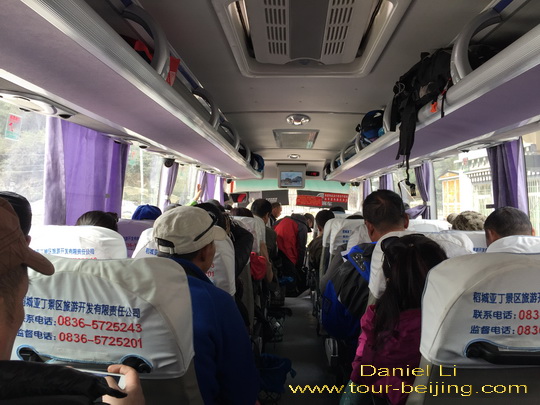
Your entrance ticket is valid for two days. We stay overnight at Longtong Ba, a bit far from the residential center of the village, the second last stop on the shuttle line. Before we get on the shuttle bus, we park our Highlander in the parking lot in front of the Tourist Service Center on the southern edge of Shangri-la Town and put our large piece of luggage on the back trunk and travel lightly to Yading Village.
The 34km shuttle ride takes about one hour, ascending from the 2900m Shangri-la Town to the 3300m Yading Village. Yading Scenic Area is named after the same name village – Yading Village.
The bus driver is very adept at controlling his bus driving over the zigzag mountain road fast and comfortable. The one hour bus ride also allows us to have a good chance to view the picturesque landscape before we start our hike from Luorong Grassland at 4180m to Milk Lake at 4600m tomorrow.
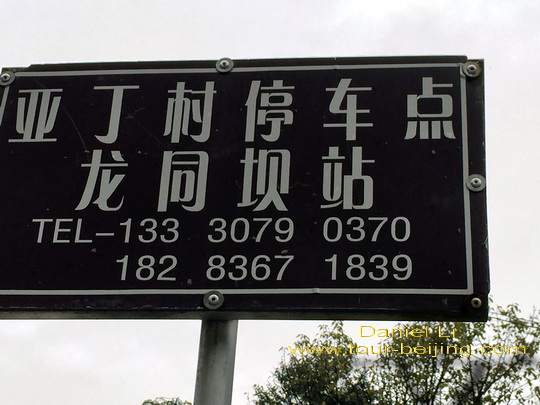
We get off at the second last stop of Longtong Ba in Yading Village, crossing the roadside stream and walking up to the temple-turned inn. It starts to rain outside. We spend the afternoon in the simple and rickety inn, praying for the fine weather for tomorrow.
Any questions on the drive from Shangri-la to Yading Scenic Area, just drop a line.
Add-on
Drive from Hanzhong to Ya’an
Ya’an Night View
Most Beautiful Sky Road in China
Moxi Old Town ( Tips, Photos & Map)
Hailuogou Glacier Camp No.04 (Tips,Photos & Map)
Hailuogou Glacier Camp No.03 (Tips, Photos & Map)
Kangding (Tips, Photos & Map)
Drive from Kangding to Xinduqiao
Drive from Xinduqiao to Danba
Jiarong Tibetan Blockhouses
Jiarong Tibetan Ancient Watchtowers
Drive from Xinduqiao to Yajiang
Drive from Yajiang to Litang
Drive from Litang to Daocheng
Drive from Litang to Batang
Drive from Batang to Mangkang
Drive from Mangkang to Deqin
Kawagarbo Viewed from Feilaisi
Drive from Deqin to Shangri-la (Zhongdian)
Ganden Sumtseling Monastery Dwells Your Soul
Pudacuo is an earthly paradise
Drive from Shangri-la to Daocheng
Drive from Daocheng to Yading
Yading Brings You Inner Peace
Hassle-free Chengdu & Sichuan Guided Tours
If you don’t want to go the do-it-yourself route and prefer the hassle-free escorted tours, here are some options for Chengdu and Sichuan guided tours:
Chengdu tour
Chengdu Car Rental with Driver
Create My Chengdu Trip
Jiuzhaigou Tour
Sichuan Tour
Further Readings
Top 10 Attractions in Chengdu
Best Time to Visit Chengdu
Chengdu Airport
Railway stations in Chengdu
Chengdu Taxi
How to visit Wuhou Shrine
How to visit Du Fu Thatched Cottage
How to visit Jinsha Site Museum
How to Visit Tomb of Wangjian
How to Visit Wangjiang Tower Park
How to Visit Qingyang Taoist Temple
How to Visit Jinli Street
How to visit Kuan Alley and Zhai Alley
How to visit Qintai Road, Qintai Street Chengdu
How to visit Shaoling Road Bar Street
How to Visit Jiuyanqiao Bar Street
The Old Teahouse in Pengzhen Town, Chengdu
Bipenggou is a fairyland in Autumn
When is the best time to visit Jiuzhaigou?
Best Places to Visit Autumn Leaves in Sichuan
Top 10 Places to Visit in Sichuan
Ruoergai Grassland, my first trip to Ruoergai Grassland






Hi Daniel
Great post!
I am traveling with my kids (7 and 9) from Lijiang to Songzanlin monastery about 5 hours south of the Yading nature reserve. Just wondering about then heading up to Yading. A few questions, if I may:
1) Is the road safe?
2) Is it feasible to “wing it”? That is, turn up in Yading and find accommodation and a guide etc?
3) what are reasonable prices for the above and can you recommend a guide?
Am also considering renting a car in Lijiang and taking our time to head up to Yading.
Grateful for your thoughts.
Best wishes
Will
Hi Will,
Sorry for my delayed reply! Songzanlin monastery itself has the legant and huge buildings with stunning views. You may check out my articlet https://www.tour-beijing.com/blog/yunnan-travel/ganden-sumtseling-monastery-dwells-your-soul for more information.
Just try to answer some of your questions:
1) Several years ago we did adventured the road trip from Shangri-la ( Songzanlin monastery) to Docheng ( and Yading). Please read my articlet for more information: https://www.tour-beijing.com/blog/yunnan-travel/drive-from-shangri-la-to-daocheng
At that time, some sections of the road were still under construction. Basically the road leading to Yading is safe with nice views. Just choose a fine day and drive carefully.
Last time we first drove from Shangri-la to Daocheng, then from Daocheng to Yading. If you drive directly from Shangri-la ( Songzanlin monastery) to Yading, I think there is another road leading to Yading. Please check it out. I’m not sure about that road condition from Shgangri-la directly to Yading. Alternatilvely you also can go first from Shangri-la to Daocheng, then to Yading. like us.
2) Yes, you can wing it. Sometime a not well planned trip will give us more surprieses and travel experiences. But it is better to book your accommodation in advance in Yading. It is not easy to find an English-speaking tour guide. Suggest you may turn to your local inn or hotel in Yading for help and travel advice on how to visit Yading.
3) The purpose of my travel writing about this area is jus for information sharing without any travel service involved. So I’m not able to offer you any prices relative to local hotels or tour guides. Sorry for that!
Have a nice trip! And take care!
Daniel
Hi Wiil,
By the way, for hotels in Daocheng, or Shangri-la Town ( not Shangri-la in Yunnan Provice), or Yading, you may check out the link: https://www.trip.com/hotels/daocheng-hotels-list-1222/
Note: Shangri-la Town is about 34km north of Yading. So you can choose one of the three places mentioned above for accommodation on your trip to Yading.